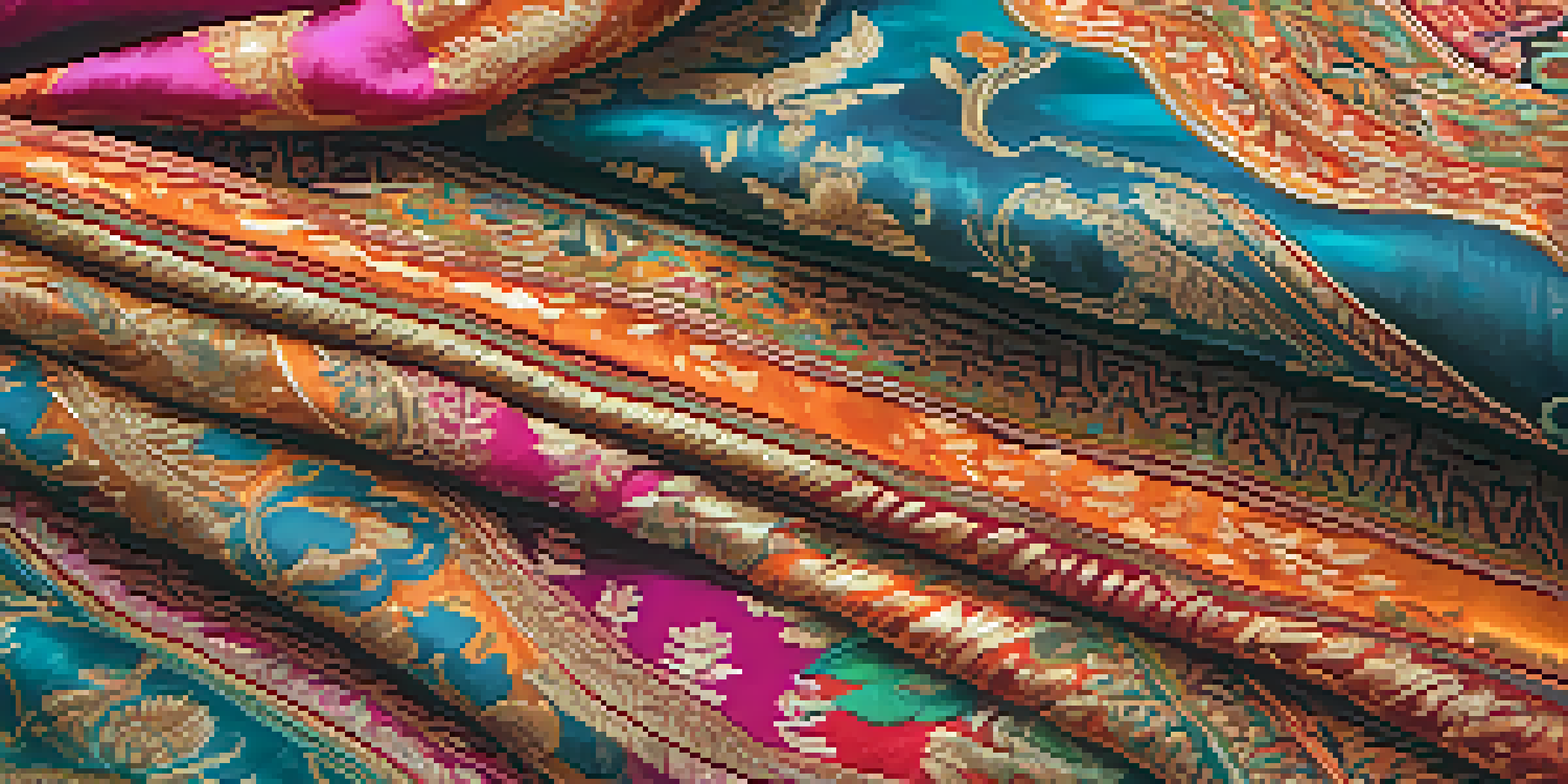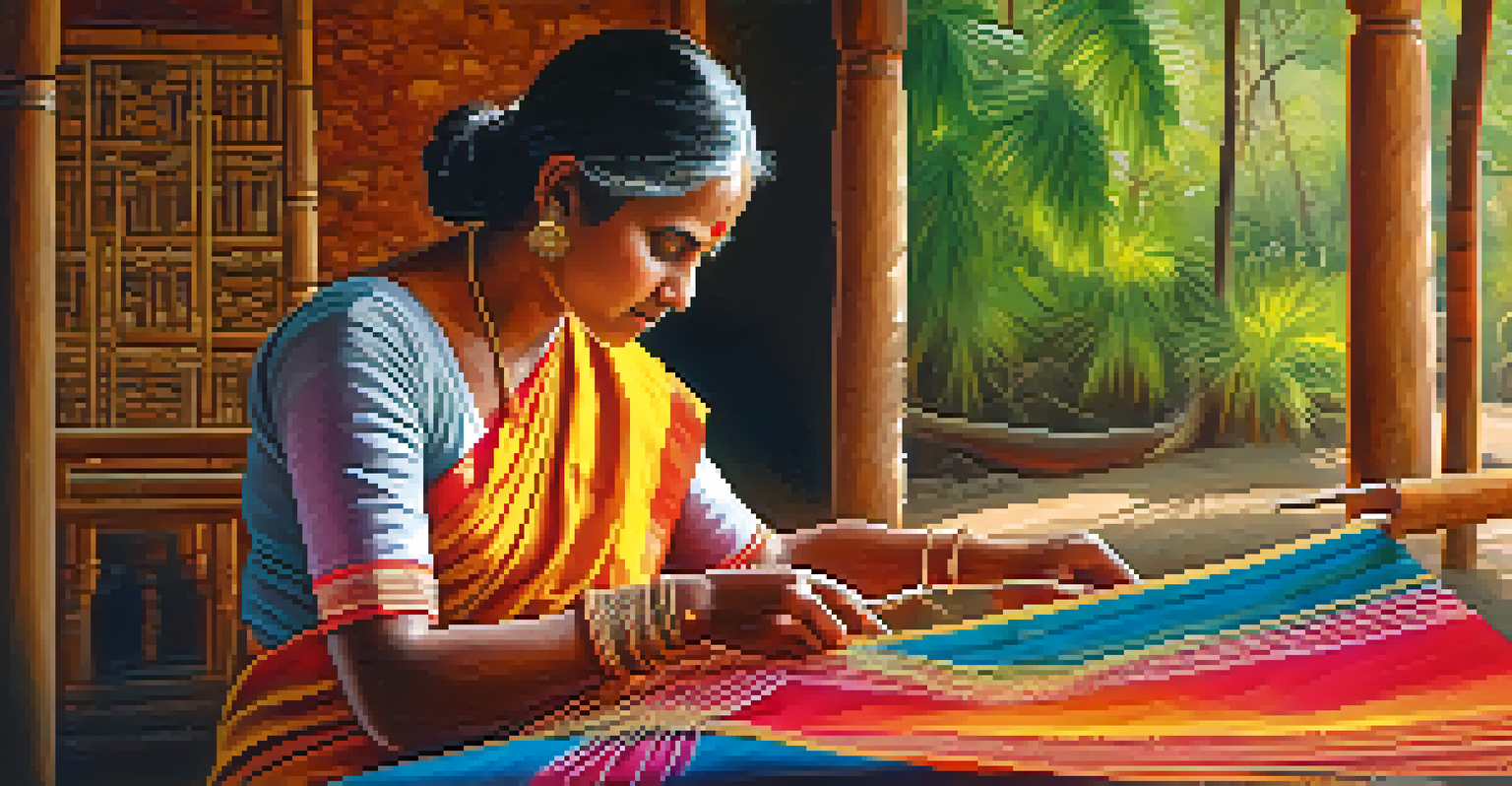A Journey Through Indian Weaving: Heritage Craft Tours

The Rich Tapestry of Indian Weaving Traditions
India boasts a diverse range of weaving traditions, each telling a unique story. From the intricate patterns of Banaras silk to the vibrant colors of Kutch textiles, these crafts reflect the cultural heritage of various regions. Weaving is not just a skill but an art form passed down through generations, often rooted in local customs and practices.
Weaving is an ancient art that tells the stories of our ancestors, a living history passed down through the generations.
Each state in India has its own distinctive styles and techniques, showcasing the artistry of local weavers. For instance, the ikat method, prevalent in Odisha and Telangana, involves dyeing threads before weaving, creating mesmerizing patterns. This variety in techniques not only highlights the creativity of the artisans but also the rich cultural diversity of the nation.
As you embark on a journey through Indian weaving, you're not just witnessing craftsmanship; you're experiencing the heart of India's traditions. By participating in craft tours, you gain insights into the stories and struggles of the weavers, making each woven piece a testament to their heritage.
Craft Tours: A Gateway to Authentic Experiences
Craft tours offer an immersive experience that connects you with the artisans behind the textiles. These tours often include visits to local villages where you can watch weavers at work, providing a glimpse into their daily lives. Engaging with the community adds a personal touch to your understanding of the craft.

During these tours, you may have the chance to participate in workshops, where you can learn basic weaving techniques. This hands-on experience not only enhances your appreciation for the craft but also allows you to create your own textile piece, a souvenir that carries a piece of the culture with you.
Explore India's Diverse Weaving Arts
India's weaving traditions reflect rich cultural stories and diverse techniques, showcasing the artistry of local artisans.
Moreover, these tours promote sustainable tourism by supporting local artisans and preserving traditional crafts. By choosing to participate, you contribute to the economy of rural communities, ensuring that these age-old practices continue to thrive.
Regions to Explore: From North to South
Each region of India offers unique weaving styles, making it essential to plan your craft tour accordingly. In the north, the beautiful shawls of Kashmir and the delicate fabrics of Varanasi await exploration. These areas are known for their intricate designs and the skilled artisans who create them.
Textiles are the fabric of our lives, connecting us with culture, tradition, and the stories of those who came before us.
Moving south, you can dive into the colorful world of Kanchipuram silk sarees in Tamil Nadu. The process of making these sarees involves meticulous craftsmanship, and you can witness the vibrant colors being woven into stunning patterns. This region's textiles are often synonymous with celebrations and weddings, offering a glimpse into their cultural significance.
In the west, the block-printed textiles of Rajasthan and the exquisite tapestries of Gujarat showcase the region's artistic expression. Engaging with these local crafts not only enriches your experience but also deepens your connection to India's rich heritage.
Meet the Artisans: Stories Behind the Craft
One of the most rewarding aspects of craft tours is meeting the artisans themselves. These skilled individuals often have fascinating stories to share about their craft and the challenges they face. Listening to their narratives offers a deeper understanding of the passion and dedication that goes into each textile.
Many artisans belong to families that have been weaving for generations. They often speak about the knowledge passed down through their ancestors, showcasing a blend of tradition and modernity in their work. This connection to ancestry enriches the cultural tapestry of India and highlights the importance of preserving these skills.
Craft Tours Enhance Cultural Connection
Participating in craft tours allows you to engage directly with artisans, fostering a deeper appreciation for their craftsmanship.
By interacting with the weavers, you not only gain insights into their craft but also foster a sense of appreciation for their hard work. Supporting them by purchasing their products helps sustain their livelihoods and ensures that these traditional crafts continue to flourish.
Sustainable Practices in Indian Weaving
Sustainability is becoming increasingly important in the world of Indian weaving. Many artisans are now adopting eco-friendly practices, using natural dyes and materials that are less harmful to the environment. This shift not only preserves the art of weaving but also promotes a healthier planet.
By supporting sustainable weaving practices, you encourage the use of traditional methods that have a lower carbon footprint. Artisans who prioritize sustainability often produce textiles that embody a sense of responsibility towards nature. This conscious approach resonates with consumers who value ethical fashion.
Participating in craft tours that focus on sustainable weaving allows you to align your values with your purchases. By choosing to buy from artisans who prioritize eco-friendly practices, you contribute to a movement that fosters both cultural preservation and environmental responsibility.
The Role of Technology in Modern Weaving
While the essence of Indian weaving lies in its traditional techniques, technology is playing an increasingly significant role in modern practices. Many artisans are now using digital platforms to showcase their work, reaching a global audience and expanding their market. This blend of tradition and technology is shaping the future of the craft.
Moreover, the introduction of modern tools and machinery has enhanced efficiency without compromising the artistry of weaving. Artisans are now able to experiment with new designs and patterns, often blending contemporary aesthetics with traditional craftsmanship. This evolution is essential for the survival of these age-old practices in a rapidly changing world.
Sustainability in Weaving Practices
Many Indian weavers are embracing eco-friendly practices, ensuring that traditional crafts continue while promoting environmental responsibility.
Craft tours that highlight these technological advancements provide a unique perspective on how tradition is adapting to modern times. By embracing innovation, artisans can continue to thrive while preserving the rich heritage of Indian weaving.
Conclusion: Weaving Memories and Experiences
A journey through Indian weaving is not just about textiles; it’s about weaving memories and experiences that last a lifetime. Each piece of fabric carries with it a story, a connection to the artisan, and a glimpse into the rich tapestry of India's culture. Engaging with these crafts allows you to take a piece of history home with you.
As you explore various weaving traditions across the country, you’ll find that each interaction deepens your appreciation for the art form. The colors, textures, and stories behind each textile create an unforgettable experience that goes beyond mere consumption.

In the end, participating in craft tours offers a chance to connect with India's vibrant heritage while supporting the artisans who keep these traditions alive. So, pack your bags and get ready for a journey that promises not just discovery but a heartfelt connection to the art of weaving.